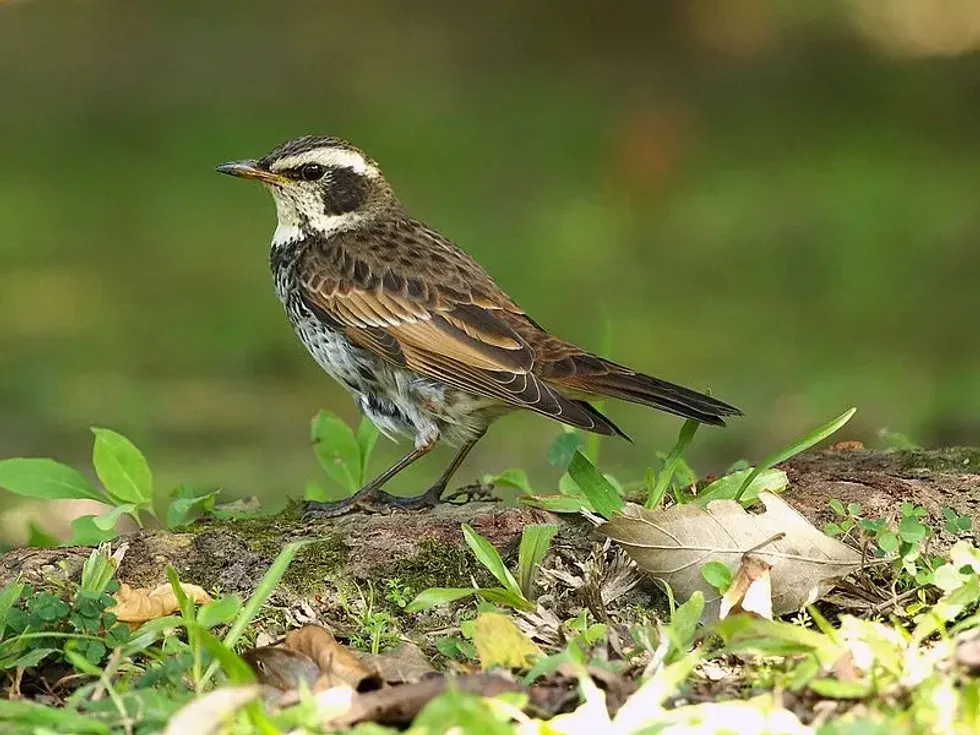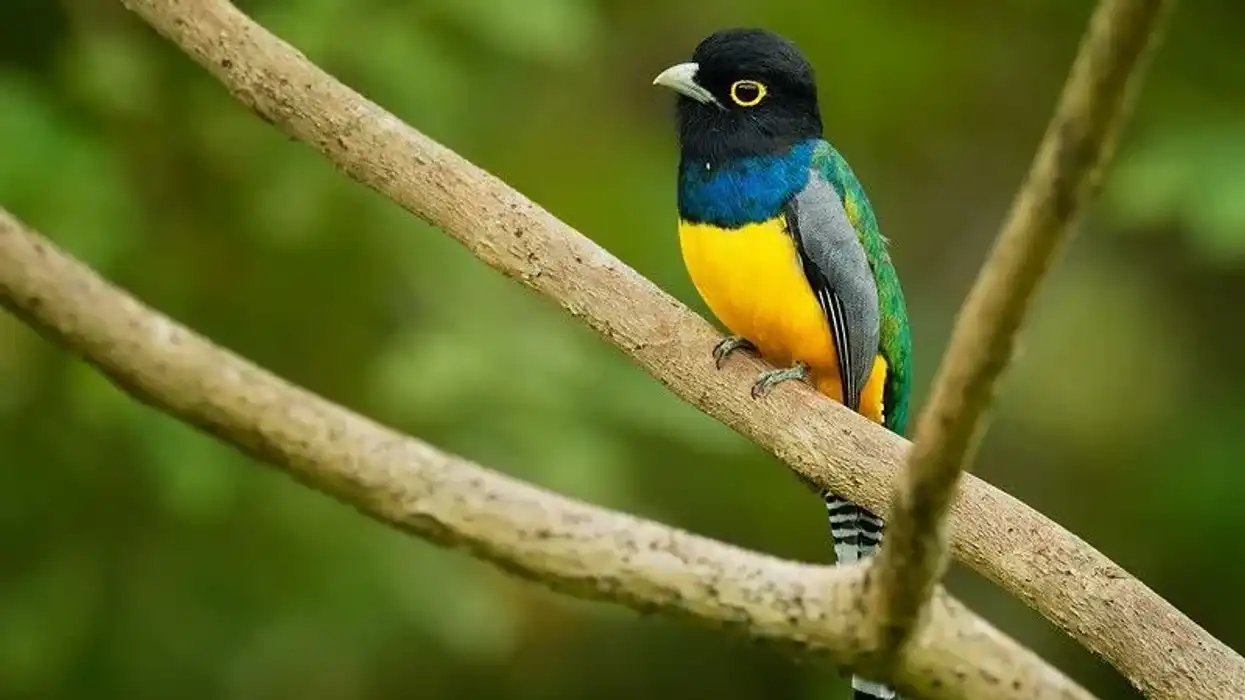A beautiful member of the thrush or Turdidae family, the dusky thrush (Turdus eunomus) breeds eastwards from central Siberia to countries in Asia such as Japan, south China, and Myanmar. The species is closely related to Naumann's thrush (Turdus naumanni). The species is an omnivore and its diet includes insects and berries.
The dusky thrush (Turdus eunomus) inhabits open forests and woodlands, dwarf willow thickets, poplar, birch, alder, and coniferous woodlands, and riverside scrub habitats. Unlike Naumann's thrush, the species also dwells in mountain areas.
The range of the species generally includes Siberia, India, Vietnam, south China, Taiwan, Korea, and Japan. A vagrant population has also been spotted in a few regions of Europe and North America such as Alaska, the Aleutians, and British Columbia in the winter.
The dusky thrush (Turdus eunomus) is one of the most beautiful birds of the world. The male dusky thrush possesses a pale grayish-brown crown and upper parts.
Its upper wings are strongly rufous-chestnut while its tail is dark brown. The adult female is more pale compared to the male and possesses a brown back and head and a spotted throat. Its underwing is not rufous, and its breast is less black.
The bird weighs around 2.2-3.1 oz (62-88 g) while its length is 9.1-9.8 in (23-25 cm). Unlike the dusky thrush, the Naumann's thrush (Turdus naumanni) has a reddish breast, flank spots, and rump.
The International Union for Conservation of Nature has listed the species in the Least Concern category while predation, a loss of habitat, and hunting are a few major threats to the species.
Keep on reading to learn more interesting facts about the dusky thrush. For more relatable content, check out these hummingbird facts and blue jay facts for kids.
Dusky Thrush Interesting Facts
What type of animal is a dusky thrush?
The dusky thrush (Turdus eunomus) is a bird that breeds eastwards from central Siberia to countries of Asia such as Japan, south China, and Myanmar. The species is closely related to Naumann's thrush (scientific name: Turdus naumanni). The species is quite rare in North America and Europe.
What class of animal does a dusky thrush belong to?
The dusky thrush (Turdus eunomus) belongs to the Aves class, the order Passeriformes, the family Turdidae, and the Turdus genus.
How many dusky thrushes are there in the world?
The exact population of dusky thrush (Turdus eunomus) birds is not known as of now but they have an extremely large range. Also, studies reveal that the population is stable as of now.
Where does a dusky thrush live?
The dusky thrush range generally includes Siberia, India, Vietnam, south China, Taiwan, Korea, and Japan. A vagrant population has also been spotted in a few regions of Europe and North America such as Alaska, the Aleutians, and British Columbia in the winter.
What is a dusky thrush's habitat?
The dusky thrush (Turdus eunomus) inhabits open forests and woodlands, dwarf willow thickets, and poplar, birch, alder, and coniferous woodlands. Riverside scrub also serves as an ideal dusky thrush habitat. Unlike Naumann's thrush, the species also dwells in mountain areas. The species construct a neatly lined nest in trees.
Who do dusky thrushes live with?
Dusky thrushes generally are solitary and they prefer to live alone, but during migration and winter, these birds are found either in loose or large flocks. Also, they are monogamous which means the breeding pair remains the same in every breeding season.
Their autumn migration takes place in September and October while their spring migration occurs from March to early May. Migrating birds are also known as wintering birds.
How long does a dusky thrush live?
The exact lifespan of dusky thrush (Turdus eunomus) birds is not known as of now but species of the Turdus genus, including Naumann's thrush (Turdus naumanni) and the song thrush (Turdus philomelos), tend to live for around two to three years.
How do they reproduce?
Like other species of thrush birds, the dusky thrush (Turdus eunomus) bird follows similar methods of breeding. The breeding season generally occurs from May to August, and during this period the birds become strongly territorial. Like other birds, the dusky thrush bird uses its song as well as head movements to attract each other.
The bird breeds in the taiga, tundra, and open woodlands, and the nest site is selected by the female bird. The nest is generally a cup-shaped structure that is made up of twigs, moss, grass, and rootlets.
It is placed on trees at 9.8-16.4 ft (3-5 m) above the ground. The female generally lays about three to five greenish-blue eggs and these are incubated for 13-15 days. The eggs are protected by male birds until they hatch.
What is their conservation status?
The International Union for Conservation of Nature has listed the species in the Least Concern category while predation, a loss of habitat, and hunting are a few major threats to the species. The dusky thrush (Turdus eunomus) bird has an extremely large range and the population is stable as of now.
Dusky Thrush Fun Facts
What do dusky thrushes look like?
The dusky thrush (Turdus eunomus) is one of the most beautiful birds of the world. The male dusky thrush possesses a pale grayish-brown crown and similar colored upper parts.
Their upper wings are bright rufous-chestnut while their tail is dark brown. The adult female is more pale compared to the male and possesses a brown back and head, a spotted throat. The female's underwing is not rufous, and the breast is less black.
How cute are they?
The dusky thrush (Turdus eunomus) bird is quite fascinating. Apart from its amazing appearance, the song of the male bird is very simple and melodious. This bird can be identified by its brown back and reddish-brown underwing and anyone would love to hear their songs and see their several courtship displays during the breeding season.
How do they communicate?
Like other birds, dusky thrushes have several songs and calls that are used to communicate. These wintering birds use their calls to find lost members of the flock, and also to indicate danger. Thrushes also possess several courtship displays.
How big is a dusky thrush?
The dusky thrush (Turdus eunomus) bird weighs around 2.2-3.1 oz (62-88 g) while its length is 9.1-9.8 in (23-25 cm). The bird is four times bigger than bee hummingbirds and ruby-crowned kinglets.
How fast can a dusky thrush fly?
The exact speed of the dusky thrush (Turdus eunomus) is not known but the species is known for its agility skills. The bird hunts insects from the ground within seconds.
How much does a dusky thrush weigh?
The dusky thrush (Turdus eunomus) weighs around 2.2-3.1 oz (62-88 g).
What are their male and female names of the species?
There are no specific names given to male and female dusky thrush birds. The female generally chooses the nest site while the male bird guards it. The structure of the nest is cup-shaped.
What would you call a baby dusky thrush?
The baby of dusky thrush (Turdus eunomus) is known as a chick.
What do they eat?
The dusky thrush (Turdus eunomus) is an omnivore and its diet generally includes insects such as mosquitos, grasshoppers, worms, and berries. These birds generally search for prey on the ground from their nests.
Are they dangerous?
Generally, these wintering birds are not dangerous and prefer not to live around humans. They possess sharp bills and can attack if someone tries to provoke or harm them. Also, males are quite territorial.
Would they make a good pet?
No, these are migrating birds and they can't survive in human-made habitats.
Did you know...
The California condor is one of the rarest birds of North America.
More than 100 species of birds are found in south China, and the dusky thrush is one of them.
Stresemann's bristlefront is one of the rarest birds in the world.
How do you identify a dusky thrush?
The male dusky thrush possesses a pale grayish-brown crown and upper parts, its upper wings are strongly rufous-chestnut while its tail is dark brown.
The adult female is paler compared to the male and possesses a dark brown back and head and a spotted throat. The underwing is not rufous and the breast is less black.
The upper parts in juveniles are buff in color while the underparts are black.
How did dusky thrushes get their name?
The scientific name, Turdus eunomus, is a combination of two Latin and ancient Greek words, the meaning of the terms are 'thrush' and 'orderly'.
Here at Kidadl, we have carefully created lots of interesting family-friendly animal facts for everyone to discover! Learn more about some other birds from our Bobwhite quail facts and vesper sparrow facts for kids pages.
You can even occupy yourself at home by coloring in one of our free printable Dusky thrush coloring pages.









